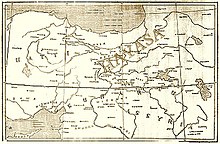
Karanni (or Lanni)[1][2] was king of Hayasa-Azzi[3][4][5] in 15th century BC. Karanni attacked the city of Šamuḫa[6] and seized city to Azzi,[7][8][9][clarification needed] so the capital had to be moved to Šapinuwa.[10]
- ^ Bryce, Trevor (2005). The Kingdom of the Hittites. Oxford University Press. p. 149. ISBN 978-0-19-927908-1.
- ^ Bryce, Trevor (2009-09-10). The Routledge Handbook of the Peoples and Places of Ancient Western Asia: The Near East from the Early Bronze Age to the fall of the Persian Empire. Routledge. p. 97. ISBN 978-1-134-15907-9.
- ^ The Armeniad: Visible Pages of History. Linguist Publishers. 2005. p. 86. ISBN 978-5-900227-09-2.
- ^ Steadman, Sharon R.; McMahon, Gregory (2011-09-15). The Oxford Handbook of Ancient Anatolia: (10,000-323 BCE). OUP USA. p. 586. ISBN 978-0-19-537614-2.
- ^ Eghiayean, Biwzand (1993). Heroes of Hayastan: A Dramatic Novel History of Armenia. Armenian National Fund. p. 21.
- ^ Bryce, Trevor (2005). The Kingdom of the Hittites. Oxford University Press. p. 149. ISBN 978-0-19-927908-1.
- ^ Burney, Charles (2004-04-19). Historical Dictionary of the Hittites. Scarecrow Press. p. 237. ISBN 978-0-8108-6564-8.
- ^ Garstang, John (2017-10-01). The Geography of the Hittite Empire. British Institute at Ankara. pp. 32–33. ISBN 978-1-912090-86-0.
- ^ E. Kretscmer, «Die nationale Nome der armenier hajkh» (1932–1933). Anzeiger der Akad der Wiss in Wien, phil-hist Klasse (in German). pp. 1–7.
- ^ It should be mentioned that there is some disagreement on the order in which Šamuḫa and Šapinuwa became capitals. Šamuḫa could have been the first substitute capital, and then Šapinuwa – or it could have been the other way around.